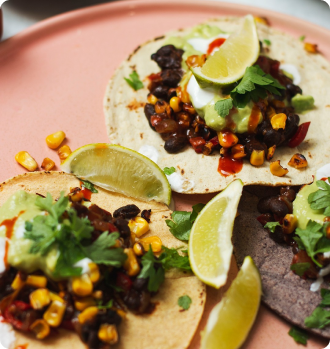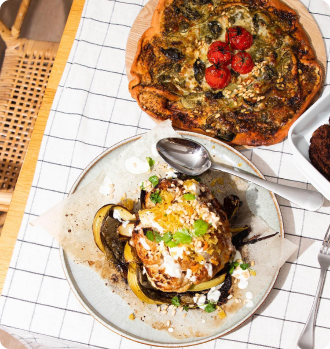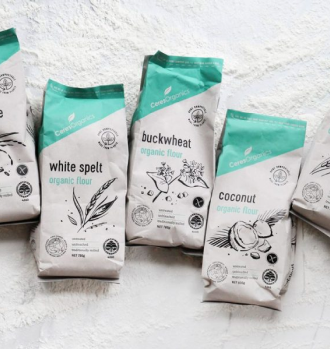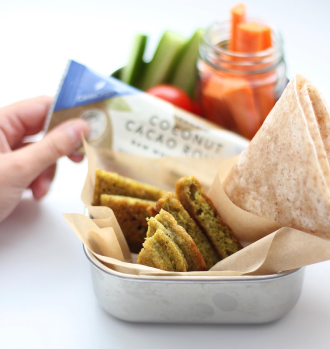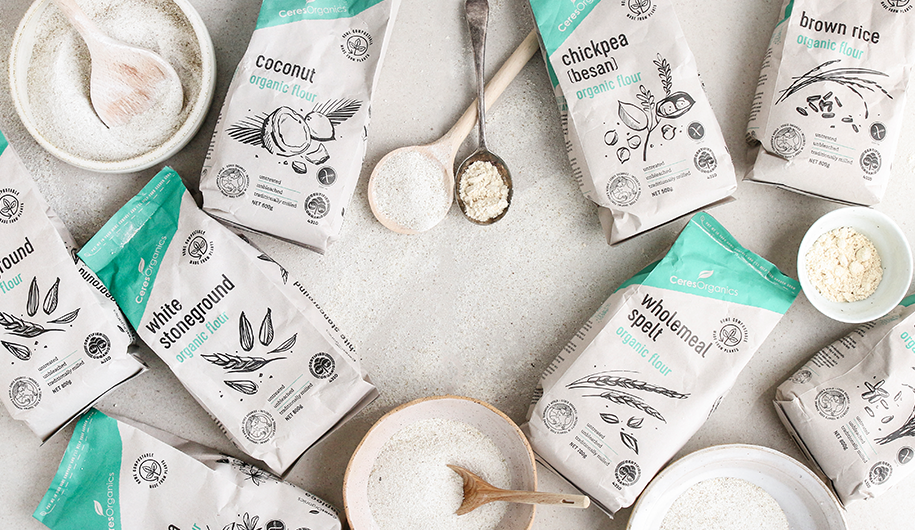
In a world filled with flowers and flours it can be overwhelming to know where to begin. So below is a little guide on each of our most trusted flours. With a few of these in your pantry, you’ll be set for any baking or cooking occasion.
Stoneground Flours
These wheat flours are produced by the relatively slow grinding of large stones together (with the wheat in the middle), the way flour was made for thousands of years before electricity came onto the scene. Because stone mills produce whole grain flour, the ground endosperm (the white bit) has the benefit of being ground alongside the nutritious germ during the whole process and, as less heat is involved, the flour retains more nutrients than regular steel milled flour. The white flour is sieved to remove coarse pieces of bran and remains a beige colour. These are great all-purpose flours, perfect for baking and bread making.
Spelt Flours
Spelt is an ancient grain, closely related to wheat, but has not been modified through intensive hybridisation, staying true to its ‘ancient’ form. While spelt flours are not gluten-free, they can be a great alternative to those with a mild sensitivity. The gluten protein in spelt has not been modified from its natural state and has a different molecular make-up than the gluten in modern wheat, which makes it gentler on the tummy. As white spelt flour has had most of the bran and germ removed, it has a ‘lighter’ touch, giving a sweet nutty flavour. The wholemeal version is a slightly denser flour with a more nutty-earthy taste. These are great alternatives to traditional white and wholemeal flours.
Buckwheat Flour
Buckwheat flour has a really fine texture, and like buckwheat grains, packed with nutrients. It works well in pancakes, crepes, noodles and breads. Buckwheat has a distinct flavour which you might prefer to mellow out by blending with other, more neutral flours, like rice or millet.
Rice Flours
Available in white and brown varieties, both are neutral-flavoured with a slightly gritty texture. For many gluten-free bakers these are an ‘all-purpose flour’, usually combined with tapioca. Rice flours are lower in protein, so when substituting in gluten-free recipes it’s worth blending them with high protein flours like quinoa or almond.
Chickpea (besan) Flour
Amazingly versatile, this is one of our favourite flours. It’s made from ground up chickpeas, so has a lovely earthy flavour that works well with savoury things, like breads and crackers. Chickpea flour is high in protein and has a dull yellow colour that it lends to foods. Not only is chickpea flour gluten-free, it’s also grain-free and nut-free, so it can be a great choice for many different needs. From pancakes, cakes, bread and cookies, chickpea flour is a pantry must.
Coconut Flour
A soft, light flour made from dried ground up coconut meat. It’s a sweeter flour perfect for cakes, muffins and loaves. Coconut flour is high in fibre, but low in carbs, which is great if you’re watching your sugar intake. One thing to be aware of when baking with coconut flour is that it’s like a sponge! Coconut flour absorbs moisture very well, so if you are making your own flour recipe to sub a whole wheat flour recipe, you will need more liquid, or you might end up with a really dry cake.
Tapioca Flour
Made from the root of the cassava plant, it has a slightly sweet taste. Tapioca flour is most famously used in rice puddings, as well as other milk-based desserts. When cooked, it gives a glossy sheen, making it a great choice for pie crusts. Because of its dense, chewy texture, it’s often used with rice flours, to ensure a lighter, fluffier result.
Almond Meal
Ground from the whole almond, including the skin, this flour is as hearty as it is nutty. You can use almond meal in recipes that call for almond flour. Probably one of the best things about almond meal is you can use it as the only flour in a recipe. You’ll find some of these in the recipes that follow.
Millet Flour
A fine-textured, light golden yellow flour, with a slightly buttery, sweet taste. You can often cut back on sugar when using it. The millet grain itself has a fair amount of starch, enabling its flour to be successfully used in gluten-free baking to create light baked goods. Millet flour is excellent for flat breads, pizza and other recipes containing yeast.
Potato Starch Flour
This is a great alternative flour that also offers resistant starch. Light and very fine, it readily absorbs water when heated, so is ideal as a thickening agent in sauces, soups and gravies. It lends a light, soft, and moist texture to baked goods that’s hard to match!
*Disclaimer: Please refer to labels for latest allergen statements and claims. The contents of this article are for informational purposes. The content is not intended to be a substitute for professional nutritional advice, diagnosis or treatment. Always seek the advice of your qualified health provider. Always refer to labels for allergen statements.



